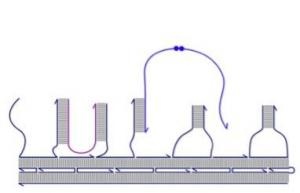Apr 3 2009
Chemists at New York University and Harvard University have created a bipedal, autonomous DNA "walker" that can mimic a cell's transportation system. The device, which marks a step toward more complex synthetic molecular motor systems, is described in the most recent issue of the journal Science.
 Chemists have created a bipedal, autonomous DNA "walker" that can mimic a cell's transportation system. Video link at bottom of page. (Credit: Image courtesy of New York University)
Chemists have created a bipedal, autonomous DNA "walker" that can mimic a cell's transportation system. Video link at bottom of page. (Credit: Image courtesy of New York University)
Two fundamental components of life's building blocks are DNA, which encodes instructions for making proteins, and motor proteins, such as kinesin, which are part of a cell's transportation system. In nature, single strands of DNA—each containing four molecules, or bases, attached to backbone—self-assemble to form a double helix when their bases match up. Kinesin is a molecular motor that carries various cargoes from one place in the cell to another. Scientists have sought to re-create this capability by building DNA walkers.
Earlier versions of walkers, which move along a track of DNA, did not function autonomously, thereby requiring intervention at each step. A challenge these previous devices faced was coordinating the movement of the walker's legs so they could move in a synchronized fashion without falling off the track.
To create a walker that could move on its own, the NYU and Harvard researchers employed two DNA "fuel strands." These fuel strands push the walker (blue) along a track of DNA, thereby allowing the walker and the fuel strands to function as a catalytic unit.
The forward progress of the system is driven by the fact that more base pairs are formed every step—a process that creates the energy necessary for movement. As the walker moves along the DNA track, it forms base pairs. Simultaneously, the fuel strands move the walker along by binding to the track and then releasing the walker's legs, thereby allowing the walker to take "steps".
The track's length is 49 nanometers—if the track was one meter long, an actual meter, enlarged proportionally, would be the approximate diameter of the earth.
For a video demonstration of the walker, go to http://www.nyu.edu/public.affairs/videos/qtime/biped_movie.mov.
The walker was created in the laboratory of NYU Chemistry Professor Nadrian Seeman, one of the article's co-authors. The paper's other authors were Tosan Omabegho, a doctoral candidate at Harvard's School of Engineering and Applied Sciences, and Ruojie Sha, a senior research associate in the NYU Chemistry Department.